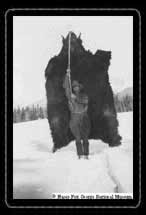Let's join a Hudson's Bay Company man on his trapline. We'll have to dress warmly as trapping is done in winter when animal furs are their thickest. This was also a good time to trap as animals were not bearing their young and parasites were absent from the pelts. Today we will travel 10–15 miles, the distance between each trap cabin along this 1,500-square-mile trapline.
Don't forget to pack your snowshoes! Long snowshoes are best for the dry snow that occurs in this region. Smaller, rounder snowshoes are good for wet snow. Snowshoes were one of a trapper's most valued possessions—as well as helping him travel through deep snow, they could also be used to dig out a snow-covered cabin.
In addition to the snowshoes, white fur traders also borrowed another piece of Carrier technology to help them trap. This was the technique of trapping known as "dead falls," and was employed by leaning one end of a log on a free-standing log and wedging the other end against a tree. A wire or string was looped around a leaning log and a tree and then looped the height of a bear's head. As the bear ambles along through the bush it unknowingly walks straight into the snare. Surprised, it tries to back out of the trap and the leaning log will drop on him, killing him.
Traders sold "made" pelts to the Hudson's Bay Company. They made these by scraping the fat off the pelt, stretching it on a frame, and then salting it. Fur was in demand as it was seen as a sign of wealth in Europe. Felt used for making gentlemen's hats, popular at the time, was made by scraping all the fur off the beaver pelt and pressing it into felt. Beaver was the most sought-after pelt for this reason.
There is a Carrier legend that tells of the origin of the beaver:
A newly married couple left their village to hunt in the mountains near a small stream. The woman grew lonely when her husband was absent and to pass the time made a small dam across the stream. Her husband found that it made the water too deep for him to wade across and so broke it with his foot. The next day she made another dam, and he broke that also. This happened again and again until she became very angry. One evening when her husband returned from his hunting he found a very large dam spanning the stream and a beaver house in the middle of the water. His wife was kneeling on the edge of the pond with her breechcloth between her legs. As soon as she saw her husband coming, she leaped into the water and entered the beaver house. She eluded all his attempts to capture her. Then a large beaver leaped out of the water and sat on top of its house. It was his wife, whose trailing breechcloth had become a tail. She called, "I have changed into a beaver. Now go back home, for I cannot live with you anymore." That is why the beaver’s belly and intestines resemble those of a human being (Jenness 1934).
The traders purchased the fish they needed to survive from the Natives though the Europeans did not appreciate the salmon as the Natives did. Dried salmon was so difficult to chew, they said, that they found their teeth became worn. The salmon "did not have much more substance than a rotten piece of wood, and weighed no more than a pound in weight " (Fraser as quoted in Klippenstein).
Even so, traders feared that their dependence upon the Carrier for fish meant the Carrier would have the upper-hand in negotiations.
By 1836 it appears that a full-fledged fisherman was on the salary role at the HBC post (HBCA as quoted in Klippenstein).
The value of a beaver:
1 large beaver = 2 small beaver = 2 lynx = 5 marten = 4 files = ¼ of a gun = 1 tin pot =
4 knives = ¼ 4-point Hudson’s Bay Company blanket = 1/20 Northwest Gun = 1/10 iron
trade axe = 60 salmon.
Later, trade tokens, which were symbols of such things as "one made beaver pelt," could be traded for goods instead of trading pelts directly.
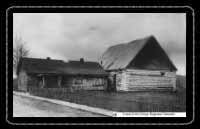
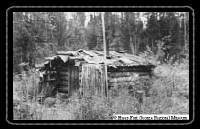
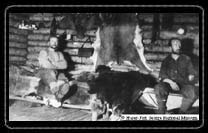
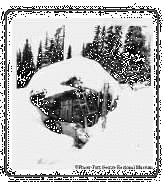



The Fur Trade
- Disease - Missionaries
Beginnings - Lheidli T'enneh
- Meeting of Two Cultures - The Pioneer Experience
Canada's Digital Collections - Home - People
- Museum - Sources - Feedback
- Glossary
